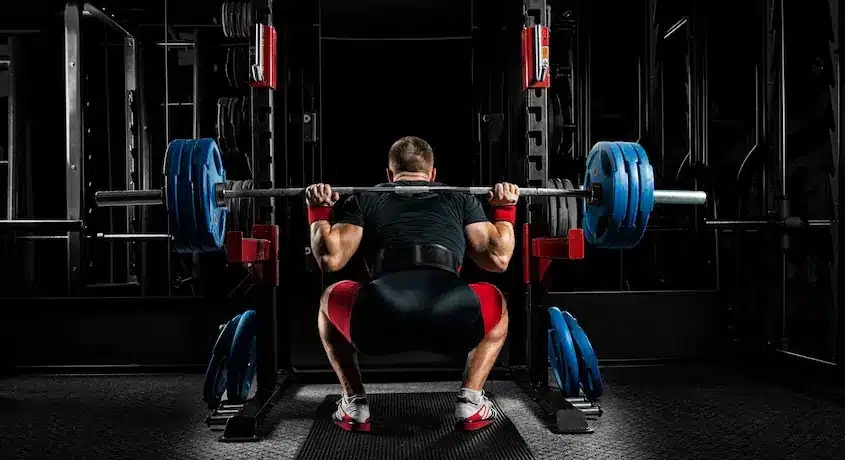Struggling to break through a strength plateau? An 8-week powerlifting program focuses on the back squat, bench press, and deadlifts. This guide offers strategies to increase your lifts significantly in just two months.
Get ready to lift heavier.
Key Takeaways
- The program splits workouts into four days each week, focusing on improving squat, bench press, and deadlift techniques while gradually increasing weight to build strength.
- During the 8 weeks, lifters go through various phases including foundation building, intensification, peaking for maximum lifts, and a deload phase for recovery before testing their progress.
- Nutrition plays a vital role in this powerlifting program. Eating more calories with an emphasis on carbohydrates helps fuel workouts and aids in muscle repair and growth.
- Recovery is just as important as lifting heavy weights. Techniques like getting enough sleep, using foam rollers, and practicing deep breathing help muscles heal faster and prepare lifters for their next workout session.
- The final week of the program focuses on performance evaluation where lifters attempt personal record lifts to measure their strength gains from the entire 8-week cycle.
Overview of the 8 Week Powerlifting Workout Program
This 8 Week Powerlifting Workout Program turns gym goers into strong lifters. It guides you through different phases, from mastering the basics to pushing your limits, with key lifts like deadlifts and bench presses leading the charge.
Weekly breakdown
This 8-week powerlifting program splits your training into four days per week. It focuses on building strength by squatting, benching, and deadlifting twice weekly.
- Week 1: Foundation and Technique – Focus on mastering the basics of squats, bench presses, and deadlifts. Use light weights to ensure proper form.
- Week 2: Building Strength – Increase weight slightly from Week 1 to start building muscle strength. Add accessory exercises like front squats and rear delt raises.
- Week 3: Intensification Phase – Add more weight to the barbell. Work on muscle growth through higher intensity lifts.
- Week 4: Mid-Program Testing – Test your progress with slightly heavier weights but focus on recovery with techniques like rest-pause.
- Week 5: Volume Increase – Lift more weights this week. Ensure a caloric surplus to support muscle growth.
- Week 6: Peaking Phase – Prepare for maximum lift attempts. Accessory work includes standing calf raises and additional hypertrophy work.
- Week 7: Deload and Recovery – Reduce weights significantly to allow muscles to recover while maintaining technique on key lifts.
- Week 8: Performance Evaluation – Measure strength progress against Week 4 tests with full effort in squats, bench presses, and deadlifts.
Each week integrates nutrition guidelines emphasizing recovery techniques vital for powerlifters’ success in meets for beginners or experienced lifters aiming for their best performance yet.
Key exercises and their benefits
Gym goers often seek effective workouts to boost strength and power. Our 8-week powerlifting program focuses on prime lifts known for their impact on physique and performance.
- Squat: This exercise strengthens the legs, core, and back. It boosts your lower body power, making daily activities easier.
- Bench Press: Targets chest, shoulders, and triceps. It improves upper body strength vital for pushing movements.
- Deadlift: Works on the back, legs, and core. Deadlifts enhance overall power and stability.
- Rear Delt Flys: These bolster shoulder joint stability and prevent injury by strengthening the rear deltoids.
- Supersets (combining exercises): Increase muscle mass through high volume training without adding time to your workout.
- Trap Bar Deadlift: Fuses leg drive and back strength more safely than traditional deadlifts due to its design.
Each of these exercises lays the groundwork for a strong powerlifting routine that also escalates strength and empowers gym goers with techniques for safer lifting practices.
Detailed Week-by-Week Guide
Jump into our week-by-week guide to shape up your powerlifting game. From ground work in foundation and technique to peaking your performance, each phase drives you closer to your goals.
Week 1: Foundation and Technique
In Week 1, gym goers focus on the basics. They learn how to do each lift correctly. This week includes squats, bench presses, and deadlifts. It’s all about getting your form right.
You must have been going to the gym for at least a year.
Master your technique now for stronger lifts later.
You do one main lift every time you work out. This helps you get used to lifting more over time. Starting with solid technique means less risk of injury and better powerlifting results ahead.
Week 2: Building Strength
Week 2 focuses on increasing the weight for primary lifts. The plan adds more sets to secondary moves. This helps muscles grow stronger and bigger. Lifters will push their limits with key exercises like squats, deadlifts, and bench presses.
This stage also raises volume. Making each session longer boosts power and prepares lifters for tougher challenges ahead. It’s a critical step for anyone aiming to excel in powerlifting competitions or looking to enhance their strength training routine.
Week 3: Intensification Phase
In the Intensification Phase, lifters handle weights close to 6% of their old one-rep max. This builds confidence with heavier loads. Gym goers push their limits by lifting more weight for fewer reps in each set.
Main lifts include squats, bench presses, and deadlifts – essentials in powerlifting meets for beginners.
This week marks a critical shift to mastering heavy weights safely. Lifters focus on form while increasing intensity. They challenge muscle strength and mental readiness for future competition stages.
Training sessions become shorter but more demanding, preparing athletes for peak performance conditions.
Week 4: Mid-Program Testing
Week 4 is all about testing your limits. You lift weights close to your old personal records (PRs). This shows how much stronger you’ve become. The focus is on the three main lifts: squat, bench press, and deadlift.
You get to see real progress.
This week helps plan the rest of your program. If you’ve gotten stronger, you may adjust future workouts to be more challenging. It’s a check-in point that ensures you’re on track for success in powerlifting.
Success isn’t given. It’s earned on the gym floor.
Week 5: Volume Increase
In Week 5, lifters boost their workout volume. They do more sets and reps but keep weights lighter than before. This shift helps muscles get used to more work without getting too tired.
Lifters focus on fixing weak spots in lifts like the squat, bench press, and deadlift. Adding supersets sharpens these improvements.
Supplemental exercises also grow in importance this week. Accessories to main lifts receive more attention. These extras polish strength gained earlier in the program while ensuring muscles develop evenly.
With no drop in intensity, consistency remains key to growth during this volume increase phase.
Week 6: Peaking Phase
This week focuses on lifting heavy weights, but avoid setting new personal records. Aim to increase the load on one set. This approach builds confidence with heavier weights without pushing too far.
Use main lifts like squats and deadlifts from powerlifting basics. Add weight carefully to challenge muscles while keeping safe. This phase prepares you for competition by maximizing strength without overdoing it.
Week 7: Deload and Recovery
Week 7 is all about deload and recovery. You lift less weight than before, keeping it just under your old personal records. This week gives your muscles a break after the heavy lifting in previous weeks.
On squat day, you go for high volume but with lighter weights. It’s crucial to warm up well and rest enough between sets.
Recovery techniques play a big part this week. They help your body heal and get stronger. Using methods like stretching, foam rolling, and getting plenty of sleep ensures you’re ready for what comes next.
Allowing your body to recover is as important as the workouts themselves.
Rest is where the magic happens – it’s when our bodies rebuild and get stronger.
Week 8: Performance Evaluation
In Week 8, gym goers test their progress by attempting three personal record lifts with safety measures in place. This week is crucial for showcasing the gains from the beginner powerlifting program.
It includes guided warm-ups before primary lifts, ensuring readiness and peak performance.
Participants evaluate strength improvements in key lifts: squat, bench press, and deadlift. This evaluation uses strict form to ensure safety and accuracy. Success in this week confirms the effectiveness of the 8-week power lifting journey for beginners, setting a new baseline for future training goals.
Nutrition and Recovery for Powerlifters
To lift big, powerlifters must eat right and rest well. They follow strict eating plans and use ways like ice baths to heal their muscles fast.
Essential nutrition guidelines
Eating more calories than you burn is key for powerlifters. Aim for a small surplus to build muscle, not fat. Focus on carbs for energy and recovery. Include proteins and fats but make carbs the star.
This fuels workouts and aids repair.
Powerlifting success starts with the right nutrition plan. A slight calorie surplus with emphasis on carbohydrates sets the foundation.
Drink plenty of water every day to stay hydrated. Dehydration hurts performance and recovery. Track your intake to ensure you’re getting enough fluids, especially during intense training days or competitions in bodybuilding or weightlifting sports like Olympic lifting or CrossFit Inc events.
Recovery techniques
Powerlifters and gym goers need recovery to stay strong and avoid injuries. Good recovery techniques boost performance in weightlifting competitions. Here’s how:
- Sleep at least 8 hours a night to help your muscles repair.
- Eat protein-rich foods after workouts to rebuild muscle tissues.
- Drink plenty of water throughout the day, aiming for 8 glasses to prevent dehydration.
- Use compression tights during and after training to improve blood flow.
- Practice hyperventilation breathing before lifting to increase oxygen delivery to muscles.
- Spend 10 minutes cooling down after every session with light jogging or stretching.
- Take one full rest day a week to allow your body to fully recover.
- Include yoga or meditation in your routine for mental recovery and stress reduction.
- Get regular massages or use foam rollers to work out knots in muscles, enhancing flexibility and circulation.
These steps ensure powerlifters stay ready for their next workout or competition, keeping fitness levels high and reducing injury risks.
Supplemental Exercises
Boost your main lifts with extra exercises. These include moves like rows and leg presses, plus cardio that keeps you fit for the big game.
Accessory lifts to complement main lifts
Accessory lifts are key for any powerlifter looking to boost their main lift performance. They target smaller muscle groups, leading to better stability and strength.
- Rear delt flys help stabilize shoulder joints, reducing injury risk.
- Supersets pair two exercises back-to-back, like bench press and bent-over rows, increasing muscle mass without added time.
- Roman deadlifts focus on the hamstrings and lower back, improving your traditional deadlift stance.
- Overhead presses strengthen the shoulders and triceps, vital for a strong bench press.
- Pull-ups enhance grip strength and back muscles, supporting all major lifts.
- Tricep dips build arm strength, essential for locking out in the bench press and snatch.
- Bulgarian split squats develop leg strength and balance, aiding squat and deadlift stability.
- Barbell rows target the upper back muscles important for a solid base in squats and deadlifts.
Each of these exercises adds value by focusing on specific muscles used in Olympic weightlifting, CrossFit Inc., and general bodybuilding practices seen on platforms like Amazon.com. The goal is to create a well-rounded athlete capable of excelling across various lifting disciplines while minimizing injury risks through improved joint stability and balanced muscular development.
Conditioning workouts for powerlifters
Conditioning workouts are vital for powerlifters. They help build endurance and improve lifting technique.
- Squat twice a week to increase leg strength and endurance.
- Bench press twice a week boosts upper body power.
- Deadlift twice a week enhances back muscles and grip strength.
- Follow Dietmar Wolf’s program for variety in conditioning exercises.
- Incorporate sprints to build quickness and explosive power.
- Add jumps to develop agility and speed.
- Use kettlebells for full-body conditioning workouts.
- Practice rowing for cardiovascular health and upper body endurance.
- Schedule cycling sessions for lower body stamina without heavy impact on joints.
- Include swimming as a low-impact exercise to recover muscles while conditioning.
Each activity is designed to complement your main lifts, following the 8-week intermediate strength block’s structure that includes these exercises for optimal conditioning among gym goers interested in powerlifting for beginners, weightlifters, and bodybuilders alike, underlining the importance of acclimatizing the body to increased lifting volumes from the first week itself.
Preparing for a Powerlifting Meet
Get ready for the big day by tapering your workouts to save energy. Focus on your mental game too, since a strong mind lifts heavy weights.
Tapering before the competition
Tapering before a powerlifting meet is crucial for peak performance. It allows muscles to recover and strength to build before the big day.
- Lower the weight volume: Start by cutting down your lifting volume by 40-60% during the final two weeks. This means if you normally lift 100 pounds, you should reduce it to 60-40 pounds.
- Maintain intensity: Keep lifting heavy but with fewer sets and reps. For example, switch from doing five sets of five reps to three sets of three reps with the same weight.
- Focus on primary lifts: Prioritize squats, bench presses, and deadlifts. These exercises are key in powerlifting competitions.
- Reduce accessory work: Minimize exercises that are not directly related to your main lifts. This helps save energy and focus on recovery.
- Increase rest days: Add an extra day of rest between workouts. If you usually train four days a week, bring it down to three.
- Stay hydrated and eat well: Drink plenty of water and consume balanced meals rich in proteins, carbohydrates, and fats for optimal muscle repair.
7 Apply proven recovery techniques: Utilize stretching, foam rolling, and maybe light yoga sessions to keep muscles loose without adding strain.
8 Visualize success: Spend time visualizing your lifts at the competition. Seeing success in your mind can boost confidence.
Following these strategies ensures gym goers head into their powerlifting competitions fully prepared, recovered, and ready to perform their best.
Mental preparation strategies
Mental preparation is key to breaking personal records in powerlifting. Consistency and dedication during training set the stage for success on meet day. Here are strategies to get your mind ready:
- Set clear goals for each training session and the upcoming competition.
- Visualize completing your lifts successfully before you even touch the weights.
- Practice positive self-talk every day to build confidence.
- Create a pre-lift routine that gets you mentally focused and pumped.
- Listen to motivational music or speeches while training to boost morale.
- Keep a training journal, noting successes and areas for improvement.
- Surround yourself with supportive people who believe in your strength journey.
- Learn stress management techniques like deep breathing or meditation to stay calm under pressure.
- Reflect on past successes before a meet to remind yourself of your capabilities.
- Accept that nerves are normal but don’t let them control you; focus on what you’ve accomplished through hard work.
These steps ensure gym goers have strong minds as well as strong bodies, ready for any challenge at a powerlifting competition.
Conclusion
The 8 Week Powerlifting Workout Program truly changes gym goers. It offers a detailed plan with muscle-building exercises, crucial nutrition, and recovery advice. Over eight weeks, lifters boost their strength through a strategic mix of lifting and rest.
This program ensures progress by targeting key muscles each session and adjusts eating to support growth and energy. Lifters see real results, hitting new personal records. With dedication, this powerlifting path leads to maximizing potential in strength training.
FAQs
1. What is an 8 Week Powerlifting Workout Program?
An 8 Week Powerlifting Workout Program is a structured plan that focuses on increasing strength in the squat, bench press, and deadlift over two months.
2. Who can follow this program?
Both new and experienced lifters who aim to improve their powerlifting totals can follow this program.
3. Do I need special equipment?
Yes, access to standard gym equipment like barbells, weights, and benches is necessary for this workout program.
4. How does this program help me compete better?
The program enhances your strength and technique in powerlifting’s three main lifts, preparing you for competition success.






